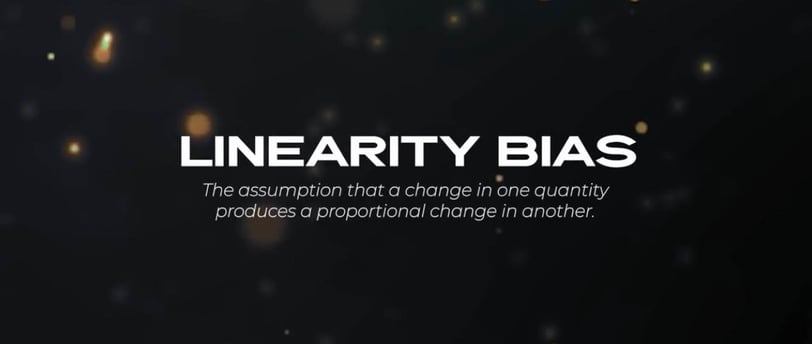Linearity Bias
Linearity Bias: The Tendency to Simplify Complex Realities
PRODUCTIVITYMANAGEMENT SELF HELP
9/30/20232 min read


Linearity Bias: The Tendency to Simplify Complex Realities
In the quest to make sense of the world around us, humans often rely on mental shortcuts and simplifications. While these cognitive tools can help us navigate complexity, they can also lead to biases that skew our perception of reality. One such bias is known as "linearity bias," a cognitive tendency to assume that phenomena and relationships are linear, orderly, and predictable, even when evidence suggests otherwise. In this article, we'll delve into the concept of linearity bias, explore its effects, and discuss how to mitigate its impact on decision-making.
Understanding Linearity Bias
Linearity bias stems from our innate preference for order and simplicity. It manifests when individuals unconsciously assume that relationships between variables or processes are linear, meaning that a change in one factor results in a proportional change in another. This bias leads people to oversimplify complex systems and overlook non-linear or unpredictable factors.
Examples of Linearity Bias
Investment Assumptions: Investors often fall victim to linearity bias by assuming that past market trends will continue indefinitely. They might expect consistent, linear growth in their investments, disregarding the potential for market volatility and abrupt shifts.
Economic Predictions: Economists and policymakers sometimes make the linear assumption that increasing government spending will always lead to a proportional increase in economic growth. In reality, economic systems are influenced by myriad complex and non-linear factors.
Climate Change: People may underestimate the non-linear and irreversible consequences of climate change, assuming that incremental reductions in emissions will yield proportional reductions in environmental harm.
Effects of Linearity Bias
Underestimating Risk: Linearity bias can lead individuals and organizations to underestimate the risks associated with complex systems. When non-linear factors are at play, risks may escalate rapidly and unpredictably.
Inefficient Resource Allocation: Assuming linearity in decision-making can result in inefficient allocation of resources. For example, investing too heavily in a linear growth model while ignoring disruptive innovations.
Failure to Adapt: Linearity bias can hinder adaptability in the face of change. When linear thinking dominates, organizations and individuals may struggle to respond effectively to unexpected disruptions.
Overlooking Feedback Loops: Many complex systems feature feedback loops that can amplify or dampen the effects of changes. Linearity bias can cause people to neglect these critical dynamics.
Mitigating Linearity Bias
Embrace Complexity: Recognize that the real world is often nonlinear and complex. Avoid making sweeping assumptions based on simple cause-and-effect relationships.
Diverse Perspectives: Encourage diverse viewpoints and critical thinking in decision-making processes. Multiple perspectives can help identify potential nonlinearities and risks.
Scenario Planning: Consider multiple scenarios when making decisions, especially in situations with high uncertainty. This approach can help account for nonlinear developments.
Continuous Learning: Stay open to new information and adapt your understanding as circumstances evolve. Be willing to revise assumptions when confronted with evidence of non-linearity.
Data Analysis: Use data analytics and modeling to identify non-linear patterns and correlations in your domain of interest. Data-driven insights can help counteract linearity bias.
Linearity bias is a cognitive tendency that simplifies complex realities by assuming linear relationships between variables and processes. While mental shortcuts like this can be useful in some contexts, they can also lead to poor decision-making and underestimation of risk. To make more informed and adaptive decisions, it's essential to recognize the limitations of linearity bias, embrace complexity, and remain open to the dynamic and often unpredictable nature of the world we live in.
